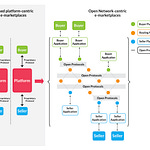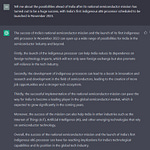MineralPolitik: REEs, If the Price is Right
— Aditya Pareek
The global contention for securing Rare Earth Elements(REE) supply chains is in full swing. Since the COVID-19 pandemic began, three countries have primarily been the movers and shakers of the REE world, the current market hegemon China, Australia, and the US.
This is directly consequential to India’s national interests, as China is its strategic adversary, and the US and Australia are its Quad allies willing to cooperate with New Delhi to counter China. However, apart from a Competition Commission of India(CCI) probe into India’s state-owned India Rare Earths Limited(IREL) for abuse of “its dominant position”, “by indulging in prohibitive increase in the sillimanite prices”, there has been little movement or development in India’s own REEs sector.
China
China has moved to centralise and consolidate a major chunk of its heavy REE industry under one state-controlled and supervised company, China Rare Earth Group.
As this briefing by renowned business consultancy, Dezan Shira & Associates says,
The new conglomerate will make up 62 per cent of China’s national heavy rare earth production.
The move is meant to ensure China’s effective control on the pricing of key heavy REEs “such as dysprosium and terbium”, this will have consequences for the worldwide pricing of these heavy REEs and their supply chains.
The prohibition of “foreign investments in exploration, mining, and beneficiation of rare earth, radioactive minerals, and tungsten”, under broader state-issued negative lists. Contrary to the Hainan Free Trade Port negative list, which says no restrictions on foreign investment will be applicable in the REE sector.
Another consolidated conglomerate with light REE producers and processing companies in China may be constituted soon for similar reasons of controlling the price of REEs.
Consistent with the picture painted by Dezan Shira & Associates, this report in Bloomberg talks of a meeting between China’s automakers, electronics producers and the Chinese Ministry of Industry and Information Technology. The meeting was reportedly aimed at discussing measures to bring down the surging prices of REEs, which is leading to higher production costs and affecting several key high tech industries.
It is also interesting to note that the Laotian Ministry of Plans and Development has been warm to China’s Tong Lee Seung Industrial Development Company exploring REEs on Laotian territory. To make matters a little complicated, this Radio Free Asia report talks about the possible uprooting of villagers from the Laotian land in question.
Australia
Among the Quad countries, Australia has emerged as the most proactive threat to China’s REEs sector dominance. The much talked about Lynas Rare Earths Ltd has seen record profits and revenue, which, according to this Reuters report is due to strong demand for Electric Vehicles(EV). Lynas was the recipient of much Australian government aid and investment recently, and the growth in its revenue and business is a positive development.
According to this FT report, Australia is looking to repeat this success with another company called Hastings Technology Metals which has set up a mine called Yangibana REEs mine in Western Australia’s Gascoyne region. The Australian government will provide “A$140mn (US$100mn)” of the total A$400mn( approx. US$ 286mn) borrowed capital needed for the project.
As the FT article says, If all falls in place,
It is likely that Hastings can become the second-largest exporter of Australian REEs. Hastings can potentially supply as much as “8 per cent of global demand for neodymium and praseodymium”, which are critical REEs used in manufacturing high-efficiency magnets for industrial and defence applications, among others.
The REEs supplied by Hastings will primarily go to the European auto industry, including vendors like Thyssenkrupp(which also makes naval submarines and warships under its HDW subsidiary).
Australia can capture as much as 30% of the total REEs market globally in the future. This is in contrast to China’s existing control of 70-90%(according to varying estimates) of the worldwide REEs market.
US
A new bill has been introduced in the US Senate, sponsored by Republican Sen. Tom Cotton and Democrat Sen. Mark Kelly, aimed at breaking China’s vice on the global REEs supply chain. Called the “Restoring Essential Energy and Security Holdings Onshore for Rare Earths (REEShore) Act”, it seeks to stop the use of Chinese REEs in US Department of Defence supplies.
Under the bill,
US Defence contractors will be required to source their REEs from elsewhere within a 4-year time frame(by 2026), with waivers applicable only in special cases. The waivers will only be allowed if REEs of the required “quantity and quality are not available at reasonable prices from sources outside of” China, and if “such a waiver is in the interests of national security”.
The manufacturers of weapons supplied to the US Department of Defence will be required to declare where the REEs used in their products were sourced from.
The US would need to establish a strategic REEs and REE products reserve that can support them even in case of a supply chain disruption for over a year.
The US will investigate China’s policies and practices in the REEs sector and if any sanctions by the US for any transgressions are required.
The US would encourage the production and use of REEs sourced domestically and from its allies instead of adversaries like China.
CyberPolitik: Moving ahead on deep synthesis tech regulation
— Sapni G K
2022 started with interesting developments on the technology regulation front. As discussed in the previous edition of this Newsletter, China’s regulatory experiments on emerging technology are underway in full swing. This week we have more information and analysis on further tech regulation experiments from China. The Cyberspace Administration of China (CAC) released the draft Provisions on the Administration of Deep Synthesis Internet Information Services last week. These draft regulations cover a broad range of technologies that use deep synthesis, which is defined as the use of technologies using generative sequencing algorithms to make text, images, audio, video, virtual scenes, or other information, as represented by deep learning and virtual reality. Media coverage of the same appears to place more emphasis on deepfakes, which is only one amongst the many use cases of deep synthesis technologies.
The provisions envision regulation as a mix of increased self-regulation alongside state supervision. Unlike other laws and drafts published recently, this draft misses a lot of granularity in the approach towards institutional capacity on regulation. It provides for contentious and controversial provisions such as real-name identity verification for users of deep synthesis services. Interestingly, this might be one of the first pieces of regulation that may have been drafted with the metaverse in mind, as the draft points to Virtual Reality as a field of application. The lack of free rein to experiment in a space where American companies have a demonstrated advantage could result in displeasure from Chinese Tech giants. This could also have interesting consequences in the application of deep synthesis technologies in military tech, as my colleague Megha wrote here.
The presumed leaders of developing global norms on regulation have been slow in catching up against such technologies. Law and regulation have historically trailed miles behind technology. It is fascinating to see changes in this dynamic. However, caution must be exercised in replicating such exercises. Multitudes of emerging technology essentially expand the horizon of expression. Deepfakes have been famously used as media of criticism, parody, and sarcasm. It is not to discredit the harms that have been perpetrated through the use of deep synthesis technology – notoriously the cases of revenge porn and financial crimes. Clearly, the line between regulation and censorship is thin. This draft also reflects the continued trend of China's heightened attempts to regulate cyberspace under the guise of preventing the propagation of false information in the interest of national security and social stability. It can only be hoped that the Chinese population and their freedoms are not sacrificed for these regulatory experiments.
Matsyanyaaya: A Four-Point Action Plan for Quantum Technologies
(An edited version of this article came out in the Hindustan Times on January 15th, 2022)
— Arjun Gargeyas
In the 2020 Budget speech, finance minister Nirmala Sitharaman announced the National Mission for Quantum Technologies and Applications (NM-QTA) with a total outlay of ₹8000 crores over five years for strengthening the quantum industry in the country. A Lok Sabha question posed in July 2021 enquired about the status and progress of the mission. In response, the Minister of State for Science and Technology, Jitendra Singh, mentioned that the mission had not yet received approval. Singh also announced that no funds were allocated, disbursed, or utilised under NM-QTA during the financial year 2020-21.
With no credible advancements made by the government, there is a need to rethink how the proposed NM-QTA will evolve if India plans to harness the benefits of quantum technology. The focus should be to develop an overarching strategy for the next 10-15 years. Adequate attention to those who can contribute to developing quantum technology must be the government’s top priority. In the current scenario, our view is that the government must follow a four-fold path to build a robust quantum ecosystem in the country.
First, the primary focus must be on establishing centres of excellence dedicated to quantum science and technology within academic institutions as well as government research institutes. Quantum technology remains a field highly concentrated in long-term research and development (R&D). Even the famed quantum industry of China started in a university laboratory, led by Pan Jianwei at the University of Science and Technology of China in 2008. In 2022, China boasts of developing the world’s first quantum satellite, creating a quantum communication line between Beijing and Shanghai, and owning two of the world’s fastest quantum computers. This was the result of a decade of research carried out in the hope of achieving critical breakthroughs. Hence, a majority of the Indian government’s outlay has to be pumped into institutions specialising in quantum R&D.
Second, the establishment of “quantum innovation hubs” in partnership with selected state governments can help direct investments efficiently and build a well-connected quantum research network in the country. These hubs, set up with the help of government resources, can serve as centres of collaboration between academia and the private sector. Finally, it is the responsibility of both the union and state governments to establish a conducive fiscal and legal environment to foster innovation. This can potentially attract international firms to conduct their research in the country while involving local talent.
Third, the power of startups and large corporations, like Google, Microsoft and IBM, involved in developing quantum technology and applications must be harnessed. The government must recognise the leaps made by these companies. While academic institutions are largely involved on the research side, quantum tech corporations and startups are vital in converting and commercialising this research into products that can be of use. The government must facilitate connections between academic institutions and industry to translate research into real-world applications.
Finally, the necessity of international cooperation cannot be ignored. The quantum value chain remains highly complicated, and it will be hard for India to remain self-reliant to build a successful quantum ecosystem. The first step could be for the government to engage with its allies in key groupings such as Quad and BRICS. Technology alliances are gaining traction, and India must look at signing some bilateral or multilateral agreements to leverage others’ growth in the domain. This is imperative for India to win critical technology transfer deals, get external technical advice or mentoring, and establish state-of-the-art facilities for joint R&D on quantum technologies.
The government has taken the first step by acknowledging the importance of quantum technologies through its plan of kick-starting a national mission in the country. The global quantum industry has already taken incredible strides and seen massive investments made by both governments and the private sector in recent years. India, which has fallen behind other technologically advanced states in the field of quantum technology, cannot afford to miss the bus this time.
Read the full discussion document on ‘Building India’s Quantum Ecosystem’ published by The Takshashila Institution.
Matsyanyaaya: Pardesi, Pardesi, Aana Nahin!
— Pranay Kotasthane (@pranaykotas)
Over the last few weeks, a few reports suggest that Technopolitik has intensified in another critical dimension: cross-border movement of high-tech human capital.
Nikkei reported that South Korea intends to keep a close tab on the movement of chip engineers across its borders. The purported objective is to discourage Chinese companies from poaching engineers and prevent tech leaks.
In January, SCMP reported that Australia and Japan now require foreign students enrolled in "sensitive" science and technology subjects to hand over detailed background data. Of course, the primary motivation, in this case, is again China.
These actions follow related developments in the US. In the first week of the year, a Chinese national pleaded guilty to stealing trade secrets from Monsanto and transferring it to the Chinese government. There was also a rather embarrassing case against an MIT professor of Chinese descent, alleging that he had failed to disclose his affiliation with Chinese institutions. The US government subsequently dropped the case.
All these incidents point towards a significant shift in technology geopolitics. As some technology areas get labelled as "critical" or "strategic", movements of professionals and international tie-ups involving China will be scrutinised closely. In other words, human capital movement restrictions will be the next frontier in pursuit of high-tech self-sufficiency.
The movement of human capital is an underrated aspect of technology geopolitics. It is a force multiplier in high-tech research and is perceived as such by nation-states. This is especially true in today's high-tech areas where international collaborations are easy, efficient, and effective. For instance, MacroPolo, a think tank, notes that over half of all top-tier AI researchers are immigrants or foreign nationals working in another country.
The host and source countries both benefit due to a dense comingling of researchers. While the benefits for the host country are obvious, the source country benefits over a longer-term — through connections to a better research ecosystem, by way of returning immigrants, or in rare cases, through blatant economic espionage.
China's attempt at tech self-sufficiency through talent transfer has three independent aspects.
First, the party-state has tried to use industrial espionage for strategic advantage.
Second, attracting human capital is seen as a legitimate path to indigenisation. Talent poaching may sound evil but is a fair strategy to build a local ecosystem by attracting talent from outside, in the hope that their prior knowledge will accelerate homegrown efforts.
Third, there has been an organic movement of Chinese researchers back home with better living conditions and opportunities — outcomes of robust economic growth for nearly three decades.
It is tough to estimate which of the three aspects have contributed more to China's rapid strides in gaining high-tech expertise. Regardless, as a whole range of technologies gets labelled as “strategic”, the first of the three aspects will gain narrative dominance, leading to stricter controls on tech transfer and people movement.
Such moves will have significant costs to both China and the host countries. But once technologies start getting defined in national security terms, cost-benefit calculations fall aside. While other countries might suffer costs, they are likely to go ahead and put barriers to the movement of people into China. To be sure, China has invited these moves onto itself because of its geopolitical conduct.
The mileage of restricting human capital movement may vary widely. For instance, nearly 10 per cent of Australia's university students are Chinese. For the government to align interests and develop the capacity to effectively screen them all is going to be a gargantuan task. Similarly, the flow of technology ideas and professionals from China into the US is too large to restrict.
Ultimately, the second-order effects at the level of international collaborations might be more significant. Scientists from these countries are likely to reduce collaborations with their Chinese counterparts, fearing government restrictions on funding and higher scrutiny on outputs.
This augurs well for India and Indians though. The China sized gap in students and researchers can only be filled by one other country. We will keep a close eye on this dimension of Technopolitik.
Our Reading Menu
[Opinion] US hawks and Chinese communists agree: no rare earths for Pentagon by Alex Lo
[Column] The Future Of EVs Depend On Rare Earths. Should The US Still Delegate To China? by Ken Silverstein
[Opinion] Rare Earths: Fighting for the Fuel of the Future by y Brendan P. Dziama, Juan Manuel Chomón Pérez, and Andreas Ganser
[Article] How Quantum Tech Could Upend Global Power Structures by Taylor Owen
[Report] Is seeing still believing? The deepfake challenge to truth in politics by William A. Galston










Share this post